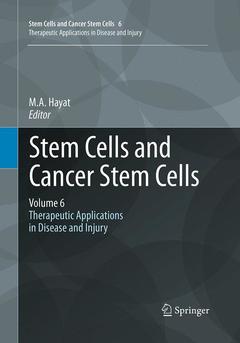Stem Cells and Cancer Stem Cells, Volume 6, 2012 Therapeutic Applications in Disease and Injury Stem Cells and Cancer Stem Cells Series, Vol. 6
Coordonnateur : Hayat M.A.

I Embryonic stem cells.-1 Propagation of human embryonic stem cell: role of tgf β.-2 Self-renewal of embryonic stem cells: cell cycle regulation.-3 Gene expression and epigenetic signatures of germ cell-derived pluripotent stem cells and embryonic stem cells.-4 Human embryonic stem cell bank : implication of human leukocyte antigens and abo blood group antigens for cell transplantation.-5 Differentiation of embryonic stem cells into glutamatergic neurons (methods).-6 Differentiation of embryonic stem cells into endoderm-derived hepatocytes.-7 Differentiation of embryonic stem cells into cardiomyocytes: role of ouabain.-8 Function of myc for generation of induced pluripotent stem cells masato nakagawa and shinya yamanaka.-9 Differentiation of human pluripotent stem cells into retinal cells.-10 Derivation and invasive function of trophoblast from human pluripotent stem cells. II Mesenchymal stem cells.-11 Differences between germ-line stem cells and multipotent adult germ-line stem cells role of micrornas.-12 Molecular and signaling pathways that modulate mesenchymal stem cell self-renewal.-13 The biology and regenerative potential of stem cells and their mesenchymal progeny.-14 Mesenchymal stem cells: clinical applications (an overview).-15 Mesenchymal stem cells for the treatment of cancer.-16 Treatment of neurodegenerative pathologies using undifferentiated mesenchymal stem cells.-17 Utility of mesenchymal stem cell therapry in type 1 diabetes.-18 Differentiation of mesenchymal stem cells into adipocyte lineage: role of cytoskeleton-associated proteins.-19 Epithelial-mesenchymal transition and metastasis: role of dicer expression.-20 Mouse bone marrow derived mesenchymal stem cells.-21 Adhesion and osteogenic differentiation of human mesenchymal stem cells: supported by b-type carbonated hydroxylapatite.-22 Immunomodulatory potential of mesenchymal stem cells on microglia.-23 Senescence of human umbilical cord blood-derived stem cells: role of histone deacetylase inhibition through regulating micrornas.-24 Stem cells in the skin.III. Hematopoietic stem cells.-25 Donor policies for hematopoietic stem cell transplantation.-26 Mobilization of hematopoietic stem cells in patients with multiple myeloma utilizing granulocyte growth factor combined with plerixafor.-27 Role of stem cells in the pathogenesis of copd and pulmonary emphysema.-28 Migration of stem cells – role of the rhoa / rock i pathway (method).-29 Hematopoietic stem/progenitor cells: response to chemotherapy.-30 Regulation of stem cells by the endocannabinoid system.-31 Chronic lymphocytic leukemia: allogeneic stem cell transplantation.-32 Peripheral blood monocytes can be induced to acquire stem cell-like properties.-33 Somatic cell reprogramming: role of homeodomain protein nanog.-34 Inhibition of breast tumor stem cells expansion by the endogenous cell fate determination factor dachshund.-35 Parkinson’s disease and stem cells.-36 Therapeutic applications of induced pluripotent stem cells in parkinson’s disease.-37 Modeling neurodegenerative diseases using pluripotent stem cells. Index.
Treatment of cancer patients
Methods for tissue engineering
Role of growth promoting factors in cancer
Treatment of injuries using cell therapy
Extensively illustrated with color figures
Date de parution : 08-2016
Ouvrage de 448 p.
17.8x25.4 cm
Disponible chez l'éditeur (délai d'approvisionnement : 15 jours).
Prix indicatif 210,99 €
Ajouter au panierDate de parution : 02-2012
Ouvrage de 448 p.
17.8x25.4 cm
Disponible chez l'éditeur (délai d'approvisionnement : 15 jours).
Prix indicatif 210,99 €
Ajouter au panierThèmes de Stem Cells and Cancer Stem Cells, Volume 6 :
Mots-clés :
Cancer therapy; Cell therapy; Regenerative medicine; Tissue engineering; Transplantation



